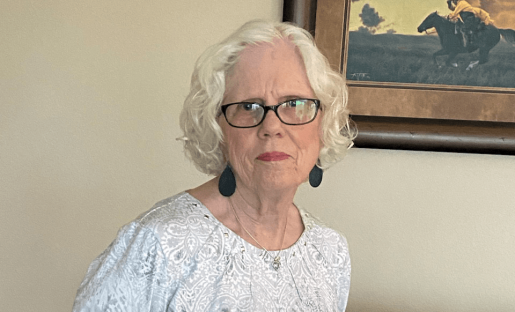Baylor surgeon treats rare condition
Superior Mesenteric Artery Syndrome (SMAS) might not be as well-known as other medical conditions, but it can significantly impact a person’s quality of life.
SMAS is a rare but severe disorder when the third part of the duodenum (the small intestine) is squished between the abdominal aorta and the superior mesenteric artery. This compression leads to various gastrointestinal symptoms and can result in severe malnutrition if left untreated.
“I see patients who come to me frustrated because they haven’t been able to find a surgeon who is familiar with operating for SMAS,” says Dr. Robert Southard, trauma surgeon and SMAS specialist at Baylor College of Medicine. “This can be a complicated procedure, but I have experience in treating it and [it] is very important for a patient to get it fixed.”

One such patient is Beverly Croniser, a Waco resident. She had lived with stomach pain for years and had been told by doctors who couldn’t figure out where her pain was coming from that she had physical pain because of emotional pain from burying two sons who died in car accidents. Initially, Croniser thought they might be right, but the pain got worse.
Not only was the pain unbearable, but Croniser says she could feel food coming up, and she became so sick that she was admitted to the hospital. After a week of tests in the hospital, Dr. Wasif Abidi told Croniser he couldn’t find what was wrong.
“I was so desperate to get answers,” Croniser remembers. “It had been years of pain and being sick. I asked him, ‘Can you think outside the box and the last thing you would test for because I don’t know what else to do.’”
Abidi did a test for SMAS and when it was positive, he called in Southard, who ended up performing surgery. Croniser had her intestine removed and her duodenum rebuilt.
“Dr. Southard saved my life,” Croniser says. “He was just so thorough, and he didn’t skip anything.”
Causes of Superior Mesenteric Artery Syndrome:
The primary cause of SMAS is the narrowing of the angle between the superior mesenteric artery and the abdominal aorta. This angle, known as the aortomesenteric angle, is normally around 38-56 degrees. However, certain factors can reduce this angle, causing the SMA to compress the duodenum. The following are some common contributing factors:
- Rapid weight loss: Extreme weight loss due to surgery, crash diets or eating disorders can lead to a decrease in the mesenteric fat pad, resulting in the narrowing of the aortomesenteric angle.
- Trauma or surgery: Abdominal trauma or surgeries can cause adhesions or scarring, altering the anatomy and putting pressure on the duodenum.
- Scoliosis or lordosis: Severe spinal curvature abnormalities can affect the surrounding structures, causing compression of the duodenum.
- Tumors or masses: Abdominal tumors or masses, such as lymph nodes or cysts, can exert pressure on the duodenum, leading to SMAS.
- Body casts: Prolonged immobilization in body casts can contribute to weight loss and fat reduction, increasing the risk of SMAS.
Symptoms of SMAS:
The symptoms of SMAS can be varied and might mimic other gastrointestinal disorders, making it challenging to diagnose. Some common signs and symptoms include:
- Severe abdominal pain: Patients often experience sharp, cramping pain in the upper abdomen after eating, especially shortly after meals.
- Nausea and vomiting: Due to the compression of the duodenum, patients may feel nauseous and may vomit frequently.
- Significant weight loss: As a result of the pain and difficulty eating, unexplained and rapid weight loss is a common symptom.
- Bloating and Distension: Abdominal bloating and distension may occur, making patients uncomfortable and lethargic.
- Malnutrition: Over time, if left untreated, SMAS can lead to severe malnutrition and nutritional deficiencies.
Diagnosis and treatment options:
Diagnosing SMAS requires a comprehensive approach, as its symptoms often overlap with other gastrointestinal conditions. Physicians will typically conduct a thorough medical history review, physical examination and imaging studies like CT scans, barium swallow studies and upper endoscopy to confirm the diagnosis.
Treatment options for SMAS include:
- Conservative management: Initially, a conservative approach often is adopted, focusing on nutritional support and weight gain. This may include enteral feeding or total parenteral nutrition (TPN).
- Nasoduodenal intubation: In some cases, a nasoduodenal tube can be inserted to relieve the duodenal obstruction and facilitate nutritional intake.
- Surgical intervention: If conservative measures fail to alleviate symptoms or in severe cases, surgical intervention may be necessary. Procedures like duodenojejunostomy, or Strong’s procedure, aim to bypass the compressed segment and restore proper gastrointestinal function.
- Postoperative care: Following surgery, close monitoring and follow-up are crucial to ensure proper healing and recovery.
To schedule an appointment with the Michael E. DeBakey Department of Surgery, call (713) 798-7911.
By Tiffany Harston, communications associate with the Michael E. DeBakey Department of Surgery



